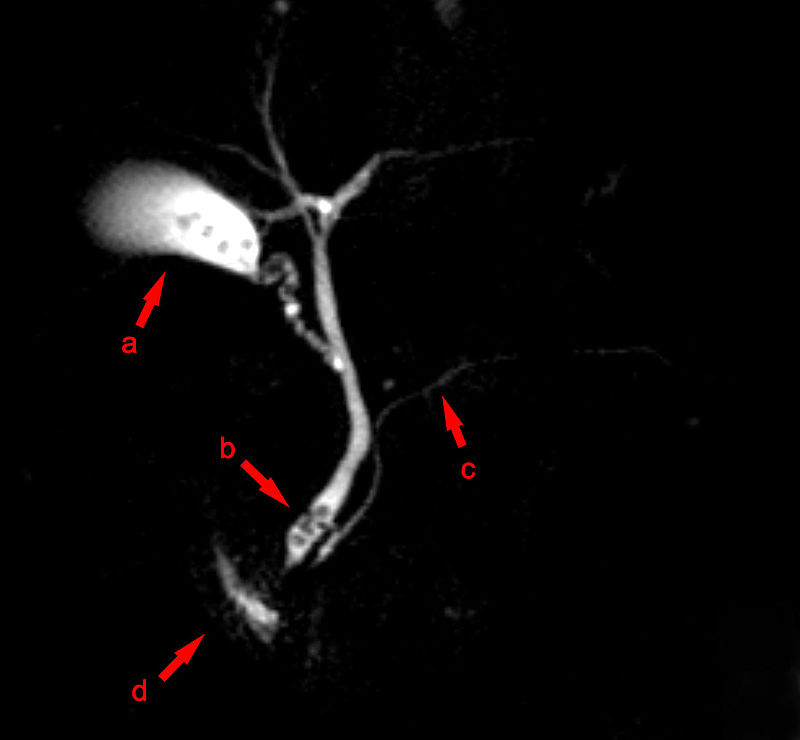Gallstone disease MRI: Difference between revisions
No edit summary |
No edit summary |
||
| Line 6: | Line 6: | ||
==Overview== | ==Overview== | ||
[[Magnetic resonance imaging]] has spawned the new field of MRI cholangiography. With or without [[Contrast medium|contrast material]], MRI is able to show the bile in the bile ducts from many different angles and can be as good a modality for detecting stones in the bile ducts as ultrasound imaging, excluding the much more interventional transhepatic cholangiogram. Problems with MRI include limited availability in certain areas, limited cholangiographic skills and experience, and relatively high costs.<ref name="pmid25719222">{{cite journal |vauthors=Gurusamy KS, Giljaca V, Takwoingi Y, Higgie D, Poropat G, Štimac D, Davidson BR |title=Endoscopic retrograde cholangiopancreatography versus intraoperative cholangiography for diagnosis of common bile duct stones |journal=Cochrane Database Syst Rev |volume= |issue=2 |pages=CD010339 |year=2015 |pmid=25719222 |doi=10.1002/14651858.CD010339.pub2 |url=}}</ref> | [[Magnetic resonance imaging]] has spawned the new field of MRI cholangiography. | ||
=== MRI === | |||
With or without [[Contrast medium|contrast material]], MRI is able to show the bile in the bile ducts from many different angles and can be as good a modality for detecting stones in the bile ducts as ultrasound imaging, excluding the much more interventional transhepatic cholangiogram. Problems with MRI include limited availability in certain areas, limited cholangiographic skills and experience, and relatively high costs.<ref name="pmid25719222">{{cite journal |vauthors=Gurusamy KS, Giljaca V, Takwoingi Y, Higgie D, Poropat G, Štimac D, Davidson BR |title=Endoscopic retrograde cholangiopancreatography versus intraoperative cholangiography for diagnosis of common bile duct stones |journal=Cochrane Database Syst Rev |volume= |issue=2 |pages=CD010339 |year=2015 |pmid=25719222 |doi=10.1002/14651858.CD010339.pub2 |url=}}</ref> | |||
===Intraoperative cholangiography=== | ===Intraoperative cholangiography=== | ||
Revision as of 18:21, 8 December 2017
|
Gallstone disease Microchapters |
|
Diagnosis |
|---|
|
Treatment |
|
Surgery |
|
Case Studies |
|
Gallstone disease MRI On the Web |
|
American Roentgen Ray Society Images of Gallstone disease MRI |
Editor-In-Chief: C. Michael Gibson, M.S., M.D. [1]; Associate Editor(s)-in-Chief: Hadeel Maksoud M.D.[2]
Overview
Magnetic resonance imaging has spawned the new field of MRI cholangiography.
MRI
With or without contrast material, MRI is able to show the bile in the bile ducts from many different angles and can be as good a modality for detecting stones in the bile ducts as ultrasound imaging, excluding the much more interventional transhepatic cholangiogram. Problems with MRI include limited availability in certain areas, limited cholangiographic skills and experience, and relatively high costs.[1]
Intraoperative cholangiography
Intraoperative cholangiography (IC) has an estimated sensitivity of 59 - 100% for diagnosing choledocholithiasis, with a specificity of 93 - 100%. However, it is highly operator-dependent and is not routinely performed by many surgeons.[2][3]
Magnetic Resonance Cholangiopancreaticogram (MRCP)
Magnetic resonance cholangiopancreatography (MRCP) is an imaging technique that uses magnetic resonance imaging to visualize the biliary and pancreatic ducts in a non-invasive manner.[4]This procedure can help determine if gallstones are lodged in any of the ducts surrounding the gallbladder.

References
- ↑ Gurusamy KS, Giljaca V, Takwoingi Y, Higgie D, Poropat G, Štimac D, Davidson BR (2015). "Endoscopic retrograde cholangiopancreatography versus intraoperative cholangiography for diagnosis of common bile duct stones". Cochrane Database Syst Rev (2): CD010339. doi:10.1002/14651858.CD010339.pub2. PMID 25719222.
- ↑ Machi J, Tateishi T, Oishi AJ, Furumoto NL, Oishi RH, Uchida S, Sigel B (1999). "Laparoscopic ultrasonography versus operative cholangiography during laparoscopic cholecystectomy: review of the literature and a comparison with open intraoperative ultrasonography". J. Am. Coll. Surg. 188 (4): 360–7. PMID 10195719.
- ↑ Videhult P, Sandblom G, Rasmussen IC (2009). "How reliable is intraoperative cholangiography as a method for detecting common bile duct stones? : A prospective population-based study on 1171 patients". Surg Endosc. 23 (2): 304–12. doi:10.1007/s00464-008-9883-2. PMID 18398646.
- ↑ Prasad SR, Sahani D, Saini S (2001). "Clinical applications of magnetic resonance cholangiopancreatography". J. Clin. Gastroenterol. 33 (5): 362–6. PMID 11606850.